
instantiator.dev
tech, volunteers, public safety, collective intelligence, articles, tools, code and ideas
- Presence (tool) (in dev)
- ListSky (tool) (in dev)
- The Epistolorean (service)
- Consensus Games (service) (in dev)
- JSON to Smart CSV (tool)
- Escape the Review (profile)
- In this house... (calendar)
Building an AWS Lambda in C#, part 5: S3
tutorialIn previous parts, we’ve built a Lambda that can query the OpenWeather API, using a secret key; and in this part we’ll extend it to write that data to S3.
Let’s build an AWS Lambda in C#
- Source code for the final project is available on GitHub: instantiator/sample-lambda-function
Part 5: Writing to an S3 object
As an example, we’ll write the data our Lambda retrieves into an object (ie. a file) in an S3 bucket, so it can be analysed later. We could just as easily store it in an RDS or DynamoDB database instance.
Create and configure an S3 bucket
First we’ll create a new S3 bucket where our Lambda can store its results, and then we’ll provide it with a permissions policy that allows the Lambda to get and put objects in it.
- Visit the S3 service in AWS console
- Tap
Create bucket
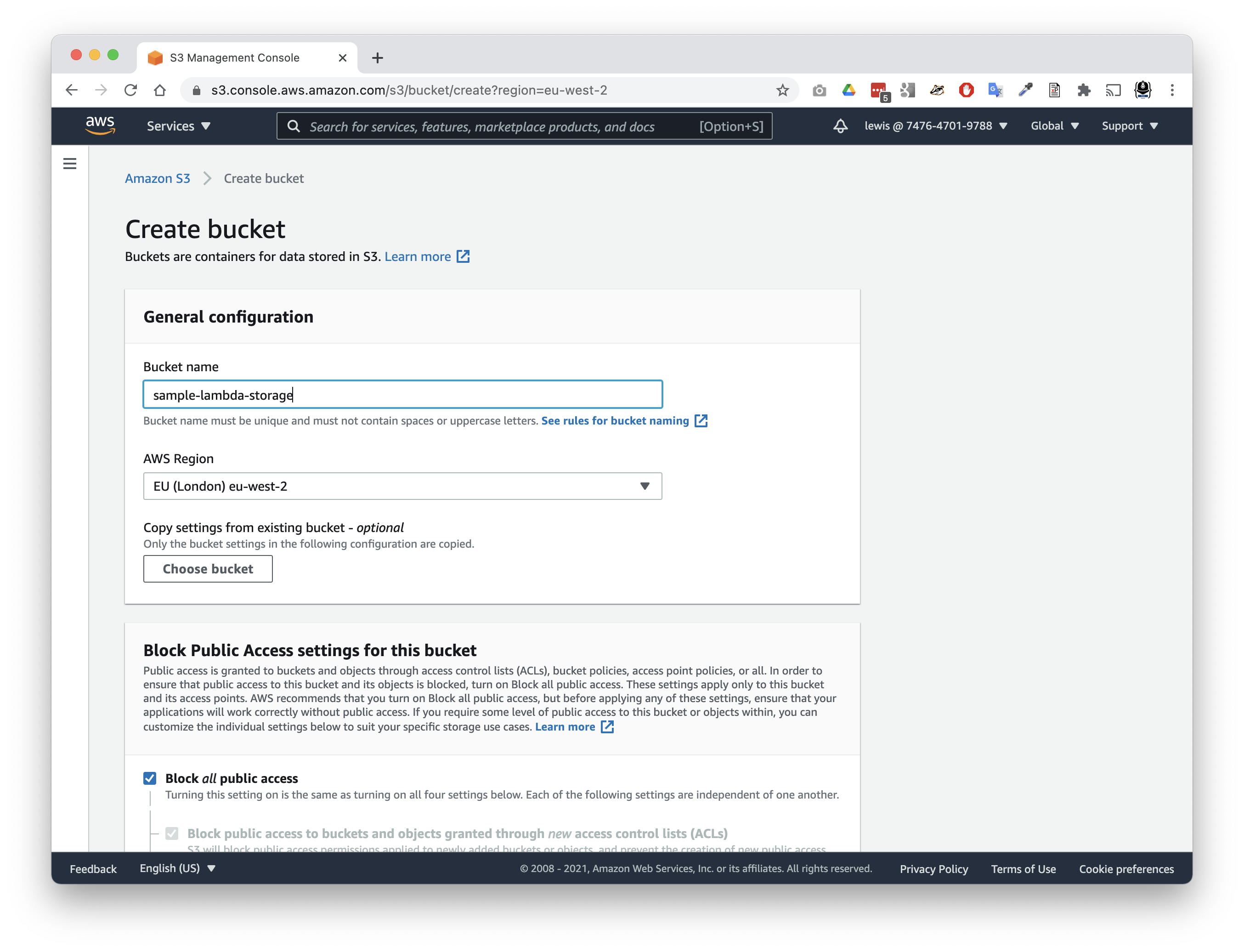
- Give your bucket a name, eg.
sample-lambda-storage - Check the region, and other defaults, look right to you
- Ensure block all public access to the bucket is selected - this bucket is for our Lambda only
- Optionally enable bucket versioning if you want to store every version of every file you overwrite (impacts storage used over time)
- Optionally enable default encryption if you want S3 to encrypt every file by default
- Tap
Create bucket
Set the bucket permissions policy
In order to control exactly what can access objects inside the bucket, it has a permissions policy - which we’ll edit now, to allow your Lambda to read and write to it.
- Visit the S3 service in the AWS console if you’re not there already.
- Choose Buckets to see a list of all buckets in the account.
- Click the name of your new bucket (sample-lambda-storage).
- Choose the Permissions tab.
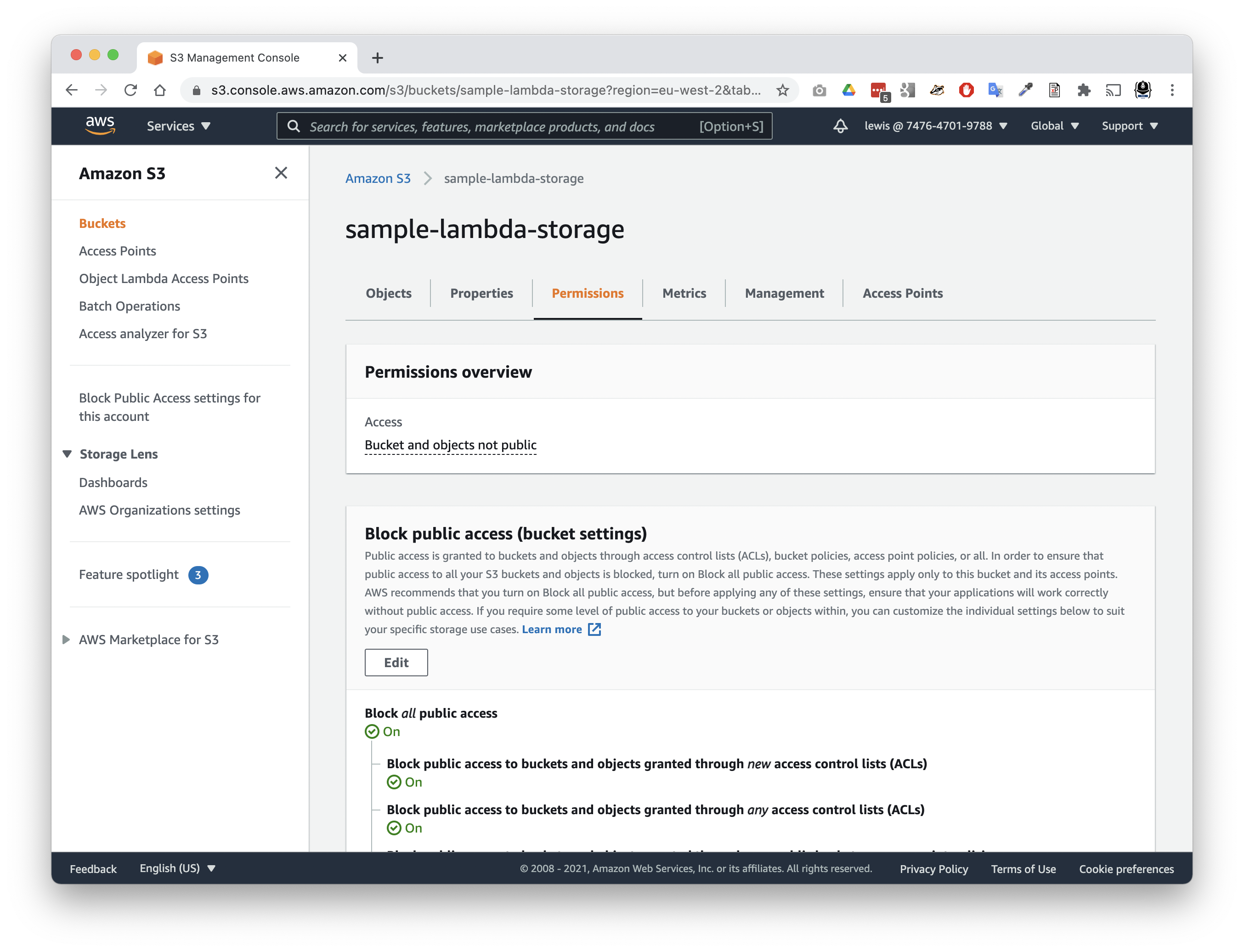
- Scroll down to the Bucket policy section.
- Tap
Edit
AWS does provide a policy generator, but in this case it’s much easier to understand what’s going on by providing the policy in text form.
- Copy/paste the policy below into your bucket policy.
- Tap
Save changesto set the new policy.
{
"Version": "2012-10-17",
"Id": "SampleLambdaStoragePolicy",
"Statement": [
{
"Sid": "statement-1",
"Effect": "Allow",
"Principal": {
"AWS": "arn:aws:iam::<YOUR ACCOUNT NUMBER>:role/sample-lambda-role"
},
"Action": "s3:ListBucket",
"Resource": "arn:aws:s3:::sample-lambda-storage"
},
{
"Sid": "statement-2",
"Effect": "Allow",
"Principal": {
"AWS": "arn:aws:iam::<YOUR ACCOUNT NUMBER>:role/sample-lambda-role"
},
"Action": [
"s3:GetObject",
"s3:PutObject"
],
"Resource": "arn:aws:s3:::sample-lambda-storage/*"
}
]
}
- Substitute
<YOUR ACCOUNT NUMBER>with your numeric 12-digit AWS account number.
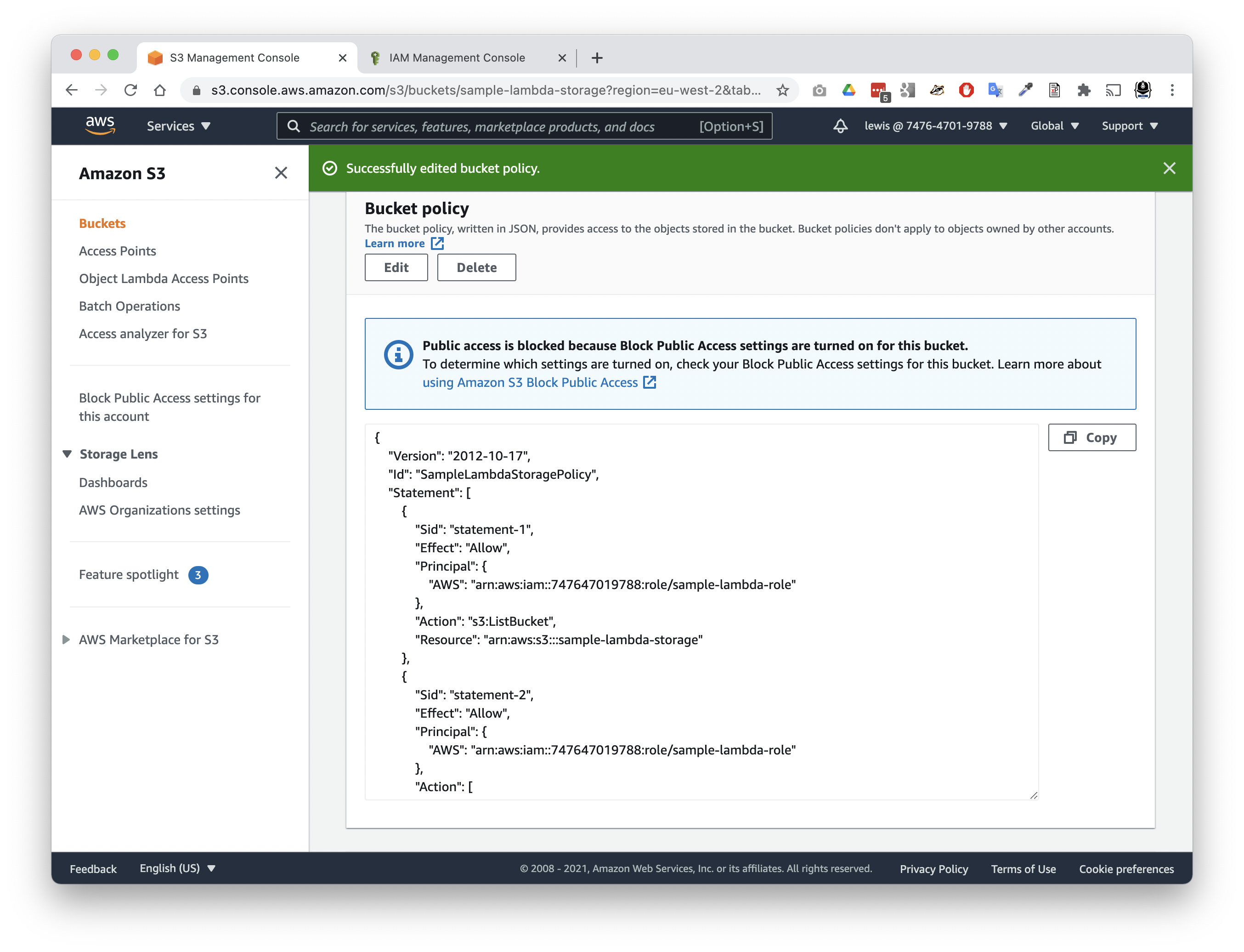
There are a few things to note about this policy:
-
It has an Id, which ought to be unique.
-
It’s broken down into 2 statements, each of which has an Sid, which ought to be unique, too.
NB. The policy generator helps to create unique values for these IDs. We’re using simpler values (
statement-1,statement-2) for the sake of visibility. You could also give them meaningful names. -
The first statement permits our Lambda to see a list of all objects in the bucket.
- The Principal is set to the ARN for the
sample-lambda-storagerole - which our Lambda assumes when it is running. - The statement grants the principal a permission (Effect is
Allow). - The permission is to see the items in the bucket (Action is
s3:ListBucket). - The permission is for the whole bucket (Resource is the ARN for the whole bucket).
- The Principal is set to the ARN for the
-
The second statement grants our Lambda permission to get and put objects from and to the bucket.
- The Principal is set to the ARN for the
sample-lambda-storagerole again. - The statement grants the principal a permission (Effect is
Allow). - The permissions are to get and put objects (Action is a list of
s3:GetObject,s3:PutObject). - The permission is for objects inside the bucket (Resource is the ARN for the bucket suffixed with
/*to indicate it applies to items inside the bucket).
- The Principal is set to the ARN for the
This policy is broken into two statements because, as you can see above, the first statement applies to a slightly different Resource (the bucket itself) than the second (items inside the bucket).
These are a simple set of permissions, and will do for our project.
There are some other permissions you could grant. It’s even possible to permit
PutObjectwithoutGetObject(and this might allow you to create a process that can submit data without ever being able to leak data from a bucket).
Using the AWS library to get and put to S3
Now that you’ve created and configured the bucket, we can update our Lambda to make use of it.
- Open up the solution in your .NET IDE, and add the nuget package:
AWSSDK.S3
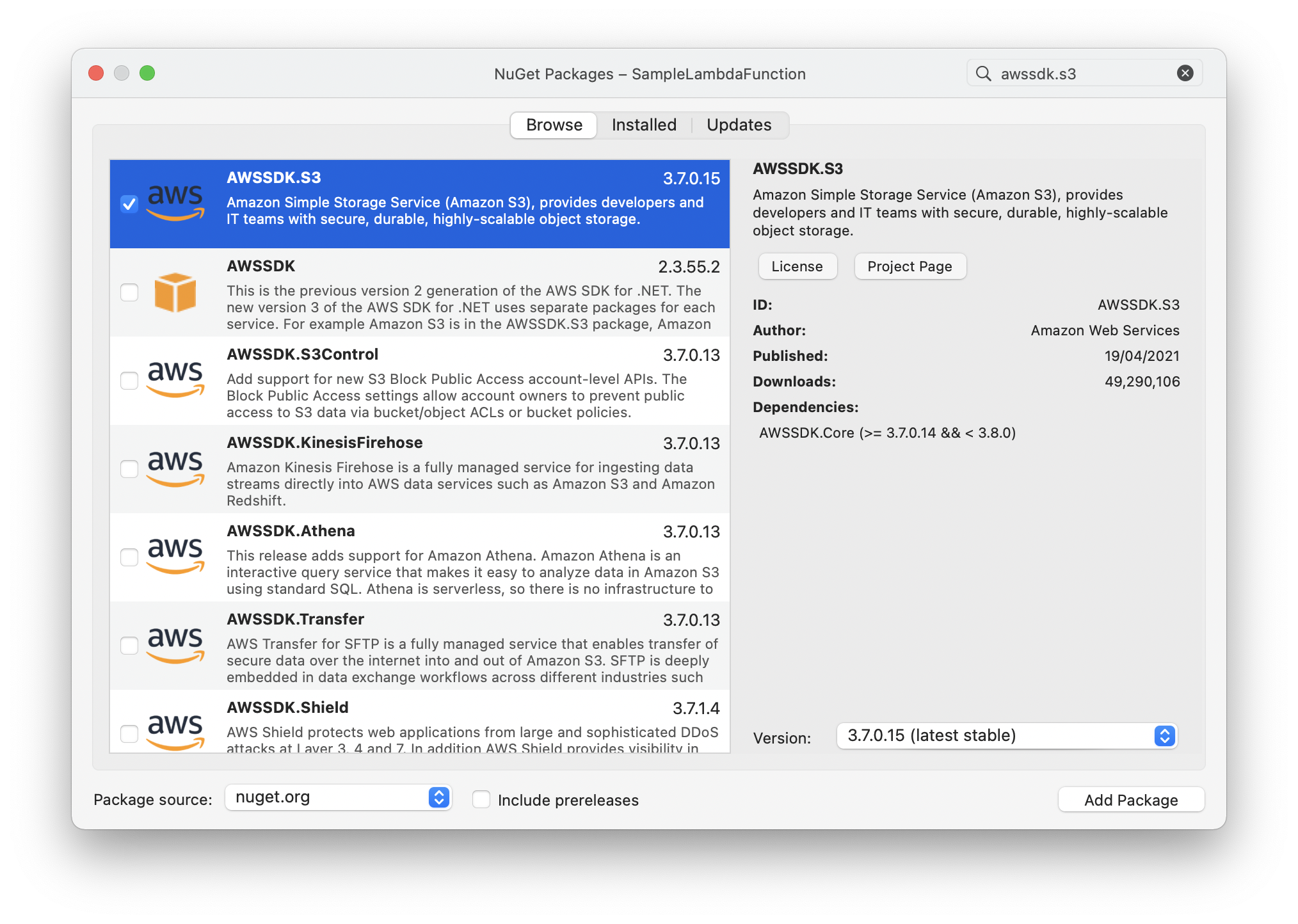
With this package, the Lambda will be able to perform PutObject and GetObject operations against your new S3 bucket.
Now open up Function.cs and add a new method to your Function class:
private async Task<bool> PutToS3Async(string bucket, string key, string content, ILambdaContext context)
{
var request = new PutObjectRequest
{
BucketName = bucket,
Key = key,
ContentBody = content
};
using (var s3 = new AmazonS3Client(RegionEndpoint.EUWest2))
{
var response = await s3.PutObjectAsync(request);
if (response.HttpStatusCode == HttpStatusCode.OK)
{
return true;
}
else
{
context.Logger.Log($"{response.HttpStatusCode} encountered putting: {bucket}:{key}");
return false;
}
}
}
A few things to note about the new PutToS3Async method:
- The method runs asychronously, as it makes asynchronous calls to S3.
- First it constructs a
PutObjectRequest, calledrequest, containing details of the bucket, key (filename), and content to write. - Then it constructs an
AmazonS3Clientin the right region to do the work. - It passes the
requestto the client’sPutObjectAsyncmethod, and waits for a response. - It returns true if the response suggests it succeeded, and false otherwise.
Now, it’s time to add a few extra lines to the FunctionHandler method. Here’s the full method, now:
public async Task<string> FunctionHandler(string input, ILambdaContext context)
{
context.Logger.LogLine("Querying OpenWeather for: " + input);
var weatherKey = Environment.GetEnvironmentVariable("WEATHER_API_KEY");
// (!) Injecting strings into your query without checking them first is dangerous. Don't do it in production!
var query = $"https://api.openweathermap.org/data/2.5/weather?q={input}&appid={weatherKey}";
using (var http = new HttpClient())
{
var output = await http.GetStringAsync(query);
var bucket = "sample-lambda-storage";
var key = $"weather_{DateTime.Now.Ticks}.json";
var stored = await PutToS3Async(bucket, key, output, context);
var msg = stored
? $"Successfully stored weather data: {bucket}:{key}"
: $"Failed to store weather data.";
return msg;
}
}
The new lines in FunctionHandler allow it to make a call to PutS3Async with the data received from the weather API call, and this causes that data to be written to an object (file) there.
- The
keyvariable is constructed usingDateTime.Now.Ticks- a quick and easy way to get a short timestamp to append to the filename. PutToS3Asyncreturnstrueif it succeeded, and so thestringreturned from the Lambda reflects this indication of success (or not).
Test the lambda again
Try it now, with:
deploy.shtest-a-city.sh
The output has changed, and is now a simple string telling us if it succeeded or not. Here’s a sample response:
Successfully stored weather data: sample-lambda-storage:weather_637545441697515760.json
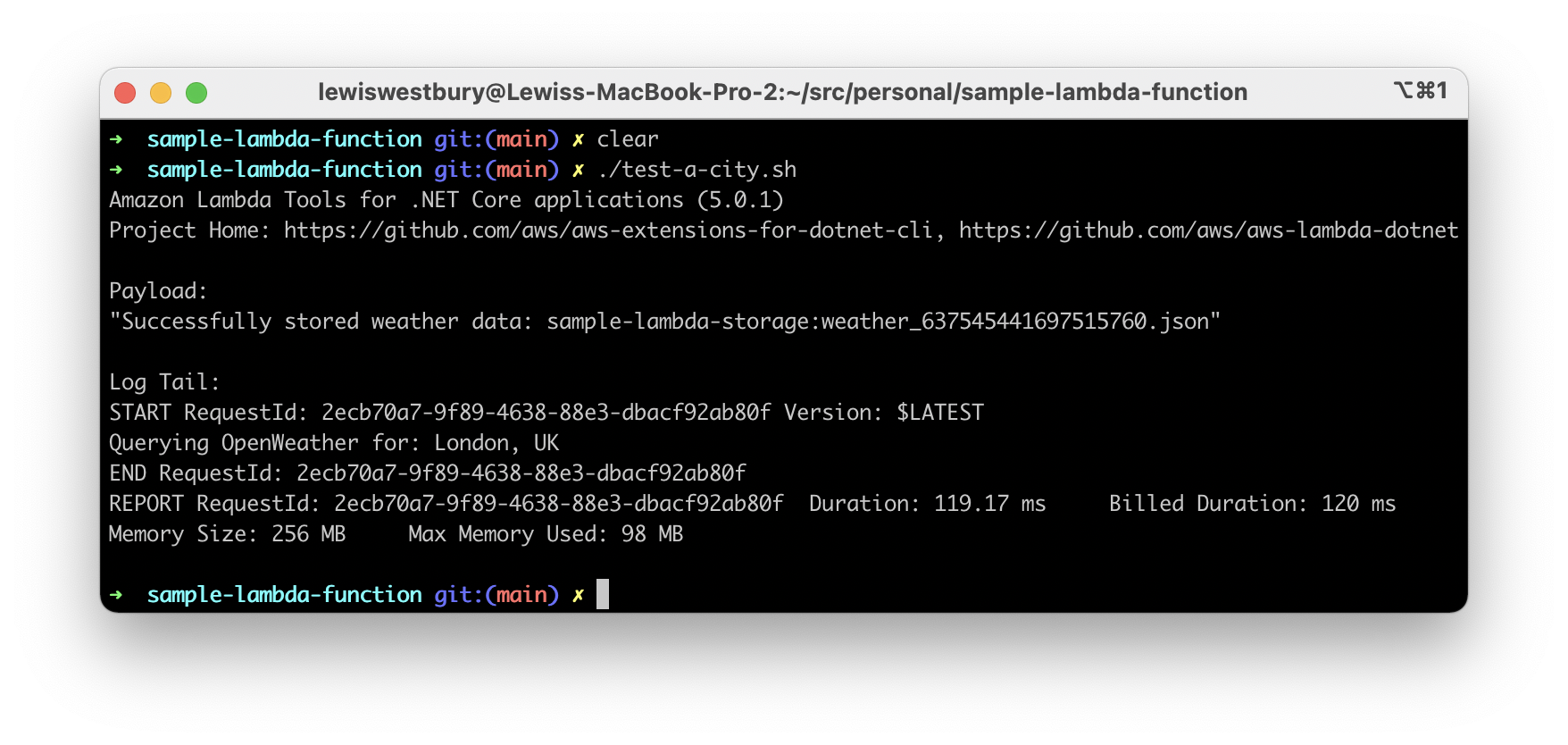
The real work of the Lambda has shifted to storing the weather data it retrieve in the sample-lambda-storage bucket. Let’s check there:
- Visit the S3 service in the AWS console.
- Click into your bucket, and select the Objects view.
- You should see your file listed there.
- Check the box next to it, tap the
Actionsbutton, and chooseDownload
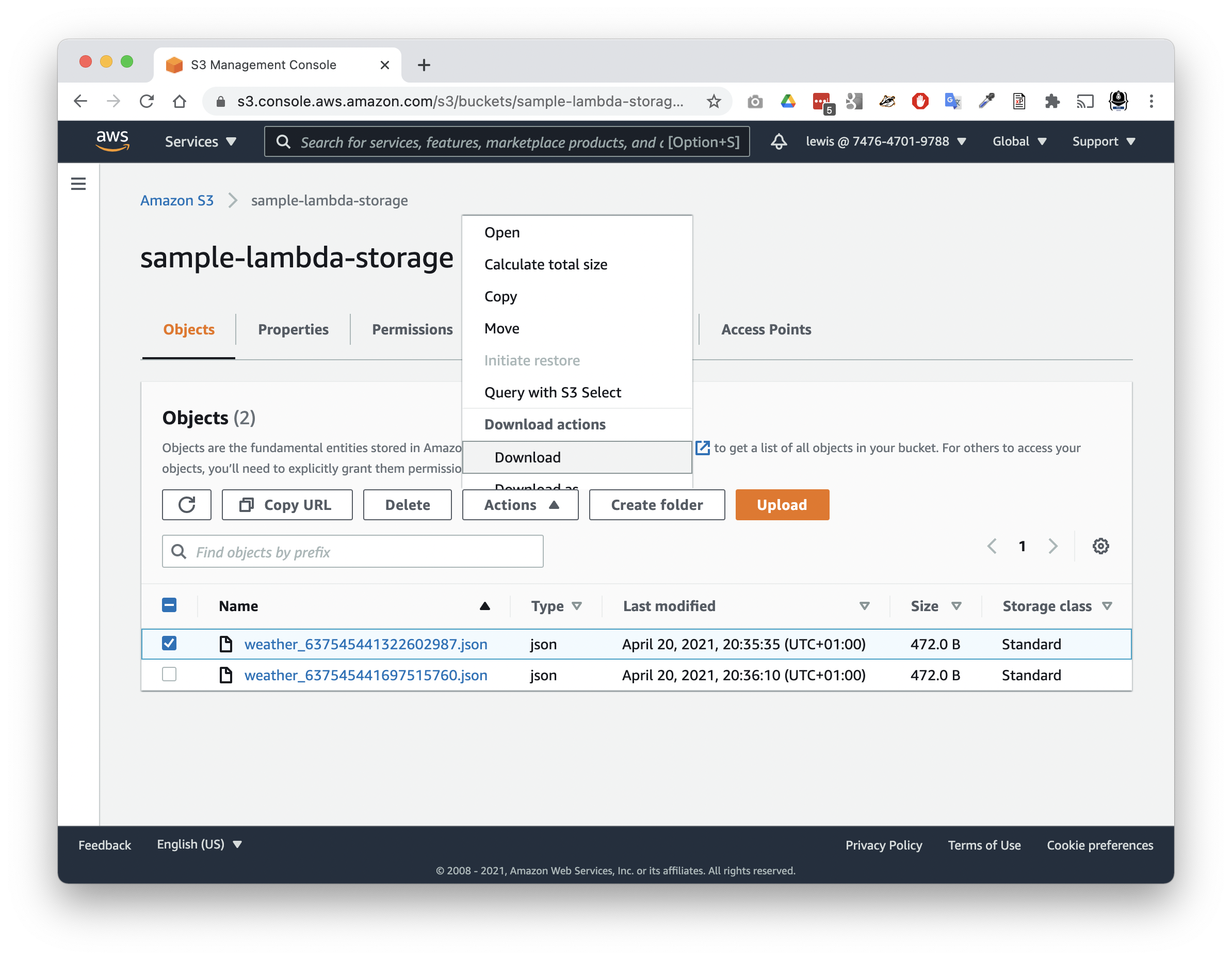
You can now take a peek at the file itself to make sure it’s the JSON data you’re expecting. It’ll look like rather a lot of JSON, all on the same line:
{"coord":{"lon":-0.1257,"lat":51.5085},"weather":[{"id":804,"main":"Clouds","description":"overcast clouds","icon":"04n"}],"base":"stations","main":{"temp":284.86,"feels_like":284.07,"temp_min":284.15,"temp_max":285.93,"pressure":1018,"humidity":76},"visibility":6000,"wind":{"speed":3.6,"deg":90},"clouds":{"all":95},"dt":1618947215,"sys":{"type":1,"id":1414,"country":"GB","sunrise":1618894425,"sunset":1618945477},"timezone":3600,"id":2643743,"name":"London","cod":200}
If you wanted to, you could reformat it to make it a little more readable, or use it in another service, or another Lambda.
{
"coord": {
"lon": -0.1257,
"lat": 51.5085
},
"weather": [
{
"id": 804,
"main": "Clouds",
"description": "overcast clouds",
"icon": "04n"
}
],
"base": "stations",
"main": {
"temp": 284.86,
"feels_like": 284.07,
"temp_min": 284.15,
"temp_max": 285.93,
"pressure": 1018,
"humidity": 76
},
"visibility": 6000,
"wind": {
"speed": 3.6,
"deg": 90
},
"clouds": {
"all": 95
},
"dt": 1618947215,
"sys": {
"type": 1,
"id": 1414,
"country": "GB",
"sunrise": 1618894425,
"sunset": 1618945477
},
"timezone": 3600,
"id": 2643743,
"name": "London",
"cod": 200
}
Conclusion
Congratulations! You’ve created a Lambda that fetches and stores current weather information whenever it is triggered.
In the next part, we’ll discuss triggers, and how you might schedule your Lambda to run regularly.